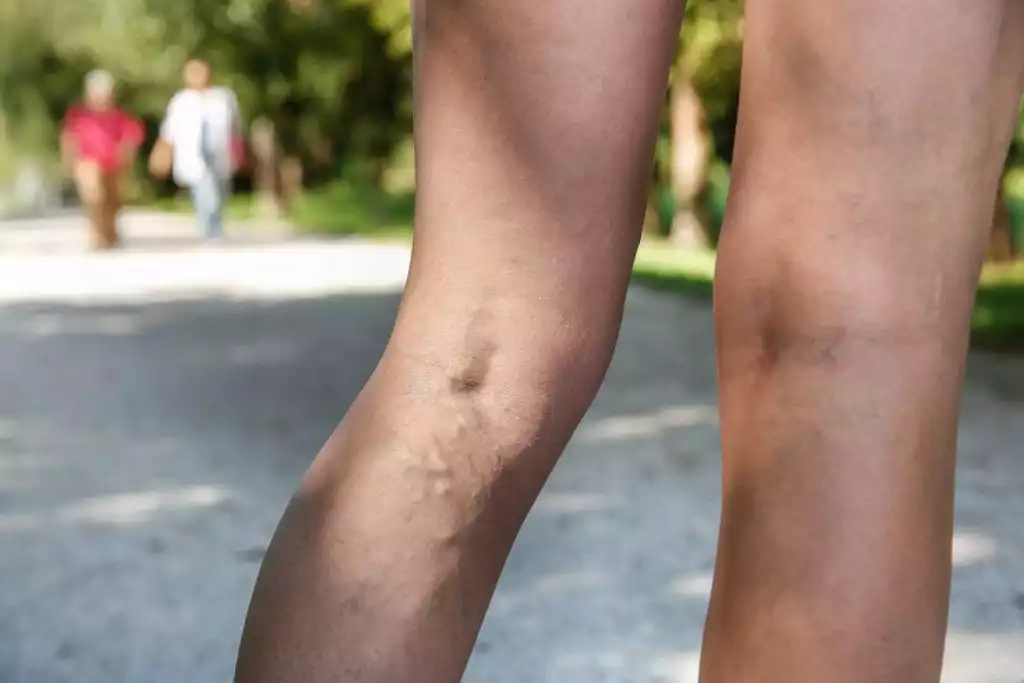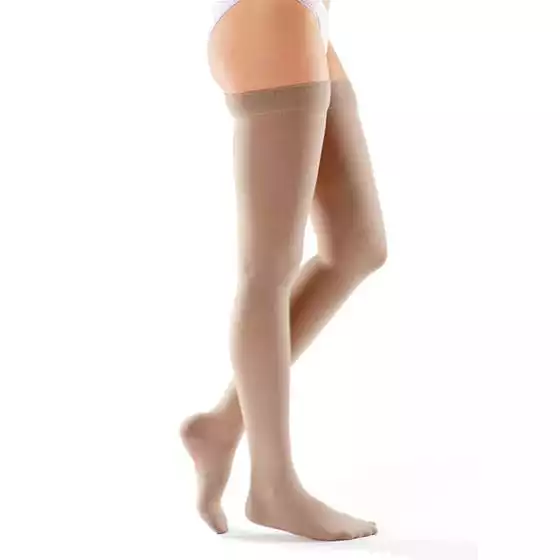
Varicose veins are enlarged, twisting and swollen veins caused by a variety of factors, the biggest of which happens to be age-related degeneration and faulty vein valves in the legs. Poor circulation may also cause blood to pool in the legs, reducing the amount of oxygen to lower limb muscles–and that can result in cramping, aching, and burning after being on your feet.
Though most varicose veins are innocuous (meaning they require no treatment), patients who experience pain or swelling may require treatment. Whether you struggle with severe varicose veins or just want to prevent your existing veins from swelling, compression stockings may be the answer.
The Anatomy of a Varicose Vein
What exactly is a varicose vein? The answer to this question starts deep inside the leg and relates to the circulatory and connective tissue itself. It all starts with the venous tissue deep in your legs. Seated among muscle and layers of subcutaneous tissue, these veins undergo constant pressure from both other tissues and gravity itself.
Varicose veins can be either primary or secondary. It’s often the primary versions that physicians notice first because they are closer to the surface of the skin, and thus, more visible. Secondary varicose veins don’t usually become noticeable until the patient is experiencing chronic venous insufficiency, a circulatory problem that reduces circulation throughout the legs.
Superficial veins (primary veins) operate under less pressure than deep veins, and as odd as it might seem, this is part of the reason why they tend to appear varicose first. With deep veins, despite the fact that they may swell, pressure deep within the leg often masks them behind layers of tissue rather than showing them at the surface of the skin. This, too, is how Deep Vein Thrombosis occurs.
So where does everything go wrong? The answer lies in the small veins that bridge the superficial venous system with the deep venous system, rather than the veins themselves. Faulty valves in these veins allow blood to leak backwards even with pressure from the circulatory system. It then pools, increasing pressure on the veins and weakening them over time.
Eventually, those veins become so stretched and weak that they overfill with blood, turning purple and swollen. Blood continues to pool, and eventually, the blood remains in the place for so long that the leg tissue doesn’t receive enough oxygen. The blood may even begin to clot–causing dangerous leg clots that can be deadly if untreated.
As we age, our cardiovascular system must work harder and harder to channel blood all the way down to the toes and back up again. This is why people who are older tend to experience more varicose veins. Researchers believe that there may be a genetic link, too–people who have weaker connective tissue may experience more varicoses earlier in life.
Why Varicose Veins Hurt
Veins don’t specifically contain nerves, which means they can’t really cause pain. The pain that people with varicose veins experience is due to:
- pressure and swelling in the tissue around a varicose vein
- reduced or increased blood circulation in the area
These factors certainly can cause a host of uncomfortable sensations that patients find troublesome. Common varicose vein symptoms and complaints from patients include:
- Burning
- Itching
- Redness
- Swelling
- Throbbing pain
- Stinging pain
- Surface-level tingling
- Neuropathic pain
- Deep, widespread aching
Any level of pain, no matter how minor, is cause for concern. If you experience pain with varicose veins, your doctor should evaluate you for both chronic venous insufficiency and to determine your risk for Deep Vein Thrombosis. Most will recommend conservative therapies like exercise and compression stockings to start.
How Compression Stockings Help
So how–and why–do compression stockings reduce the pain experienced with varicose veins? As it turns out, they alleviate pain because they increase pressure on the outside of both primary and secondary varicose veins. That pressure makes it easier for the heart and circulatory system to pull the blood back up through the body and to the heart. It’s effectively granting your cardiovascular system a “leg up” (pardon the pun) against gravity. With less blood pooling in your legs, less swelling will occur, and that means less irritation, too.
A Practical Example
Picture a flexible hose with a balloon on the end. You fill it with water; the water channels through the balloon and pools there. This is like a varicose vein. The balloon itself cannot contract to push the liquid upwards, so it remains in place.
Now, picture wrapping two hands around the balloon and squeezing gently. The liquid is likely to begin moving back up the hose and circulating through it once again. This is the effect gained when wearing compression stockings. The gentle pressure encourages blood to continue back up the damaged veins to healthier areas of the leg, where your own circulatory system can more effectively channel it through to the heart.
Wearing compression stockings also has one more main benefit: that increased pressure is shown to reduce the risk of Deep Vein Thrombosis. If you’re on hormone replacement therapy or you’ve had a blood clot in the past, it’s advisable that you be fitted for stockings to reduce future risk.
Can I Wear Any Stocking?
Absolutely not. Despite the fact that most drug stores and pharmacies sell compression stockings, you should always be fitted prior to purchasing your first pair. Wearing stockings that are too loose will negate any beneficial effects, while wearing stockings that are too tight can cause tissue damage due to lack of circulation. Have someone on your medical care team measure and evaluate which size and pressure is best for your condition–no matter if your varicose veins are mild to severe.
Although varicose veins are often a pain, they are little more than that for the vast majority of patients. Early detection and care is the best way to prevent your varicose veins from progressing into chronic venous insufficiency. For questions about varicose vein treatments, speak with your pharmacist directly.

 info@burtsrx.com
info@burtsrx.com

Varicose Veins are also called as Spider Veins. Varicose veins can cause skin damage, even worse, and lead to the dangerous blood clots. This is really a perfect answer of the question. And I agree with this answer. Thanks for sharing!